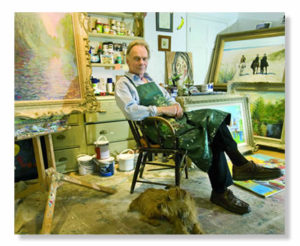I just finished reading Provenance: How a Con Man and a Forger Rewrote the History of Modern Art. Excellent read. I highly recommend it for the intrigue and insight into the world of auctions, dealers, and museums.
It got me thinking about this age-old question.
If a purported masterpiece fools even the experts, why is it worth less after it’s discovered to be a forgery?
It’s the same painting as it was the day before. Yet it’s worth millions less on the market.
Is it fair?

Bonus: Check out John Myatt’s site. He’s the artist-forger featured in Provenance.
Image ©John Myatt



10 thoughts on “Fakes that Fool the Experts :: Deep Thought Thursday”
Why would it? Art is only slightly about the visual and technical capability – otherwise a photo would be worth as much.
This is something I was thinking about a lot when the Hitler watercolors came on the market and everyone was fascinated by them, whether or not they wanted to buy them.
Why did we care? Why did we want to see them? It was all wrapped up in the artist’s name. And it has to do with the modern desire to psychoanalyze an artist through what she-he makes.
Hi Alyson,
I don’t think it’s about just the name. I think it’s about cheating.
There are probably quite a few artists who could accurately
replicate a Monet, or Jack Bush, or Rauschenberg, but what
gives the paintings value is both the name of the prominent artist,
and the authenticity. The art world, like the rest of the world
doesn’t like being duped. This makes sense to me.
Sounds like a great read, and it’s a super blog topic.
Barbara
Where this question gets really thorny is when one considers minimal and conceptual art. There is often little technical skill required for their creation, or the artist merely draws a rough plan and has others manufacture the piece for him or her. With no other clear standard to go by, collectors and curators start putting enormous importance on who came up with an idea first.
For forgers making fake Andy Warhol’s or Don Judd’s life has gotten a lot easier. It makes me glad I’m a landscape painter.
I read this book a few months back and it was a good read, especially considering that it was a true story and that they carried off the scam for so long. I wrote a review of it here: http://capappasart.com/2010/02/21/provenance-book-review/
In my mind, “fair” is often too much of an absolute word to use when describing prices. People rarely act on a strictly rational level and as Gwenn said, there is some kind of phychological aspect to it. I also think that once people discovered the paintings were forged, they wouldn’t want the stigma of having purchased the works (buying works made by con men). With no demand, the paintings were therefore worthless.
A lot of what makes great art is how it pushes the boundaries of art making, so an artist that came up with something revolutionary, although not always recognized for it (Van Gogh for example was just not fashionable in his day), but we now recognize he was at the vanguard of a new movement in art, thus his paintings became more valuable. So a copy of one of his works is not doing anything revolutionary, it is just recreating what already exists, thus the value is not in how it looks but what it represents. A copy is just that – a copy.
exactly what Karen said. Art is much more than visual and technically ability.
*technical
(and what Jeff initially said as well)
I have to agree with Barbara. It’s about cheating. If someone forges my signature on a check, it’s worthless. A student who plagarizes a term paper gets a failing grade. It doesn’t matter if they retyped the entire paper, typing is not the same as developing original ideas.
Same with forging an artwork: copying is an entirely different effort and process than creating it the first time.
A related article from the Wall Street Journal: http://online.wsj.com/article/SB10001424052748704901104575423392180989062.html?mod=WSJ_ArtsEnt_LifestyleArtEnt_4